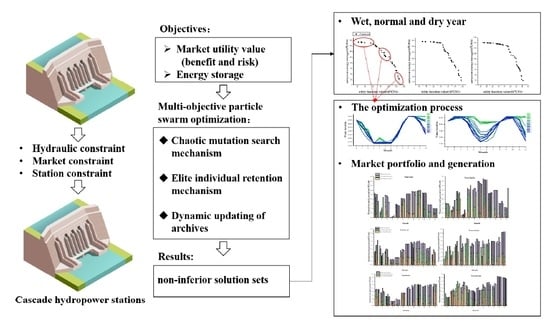Multi-Objective Optimal Long-Term Operation of Cascade Hydropower for Multi-Market Portfolio and Energy Stored at End of Year
Abstract
1. Introduction
2. Objectives and Constraints
2.1. Obejctieve
2.2. Station Constraint
- Water balance constraint: ensure the water balance of upstream and downstream power stations and adjacent periods, as follows:where and are the storage capacity of hydropower station in the period and , measured in ; represents the inflow of hydropower station in the period , measured in ; represents the generation flow of hydropower station in the period , measured in ; represents the spillage water flow of hydropower station during the period , measured in ; and is the number of hours for the period.
- 2.
- Water level restriction: the water level restriction of hydropower station dispatching ensures that the reservoir operates within a safe and reasonable water level range:where represents the water level of hydropower station in the period ; and are the lower limit and upper limit of the water level of hydropower station in the period , respectively, measured in m.
- 3.
- Output constraint: the upper and lower output limits of the hydropower station are determined according to the nameplate output, maintenance plan, minimum technical output limit, etc., of the hydropower unit:where represents the output of hydropower station in the period , measured in W; and are the lower and upper output limits of hydropower station in period, respectively, measured in W.
- 4.
- The turbine flow constraint mainly depends on the overflow capacity of all water turbine units of the hydropower station:where represents the turbine flow of hydropower station in the period , measured in ; and are the lower limit and upper limit of the turbine flow of hydropower station in period , respectively, measured in .
- 5.
- Water discharges constraint: the discharge limit of a hydropower station is related to the discharge capacity of the hydropower units and the discharge capacity of the spillway:where represents the discharge of hydropower station in period , measured in ; , represent the lower limit and upper limit of the discharge of hydropower station in period , respectively, measured in .
- 6.
- Power generation function:where represents the average gross water head of station in period ; is the average tailrace level of station in period ; and represents the water released-energy conversion function of station .
- 7.
- Carryover energy constraint, based on the expression in [4]:where represents the storage of station in period ; is the minimum storage of station; is the sum of the storage of station and its upstream station, measured in ; and is the average water consumption rate of station , measured in .
- 8.
- The relationship between the water level and reservoir storage:where represents the water level as a function of station storage for station .
- 9.
- Relationship between the tailrace water level and reservoir discharge:where represents the tailrace water level as a function of reservoir discharge for station .
- 10.
- The market electricity of a station is calculated as follows:where represents the total market electricity of station in period , measured in .
3. Model Solving Method
3.1. Mean-CVaR Market Model
3.1.1. CVaR Model
3.1.2. Mean-CVaR Utility Function
3.2. Solution of Cascade Multi-Objective Optimization Problem
3.2.1. Standard Particle Swarm Optimization
3.2.2. Multi-Objective Particle Swarm Optimization Algorithm
- Chaotic mutation search mechanism
- Elite individual retention mechanism and dynamic updating of archives
3.3. Overall Solution Framework
4. Case Study
4.1. Basin Cascade Data
4.2. Electricity Market Information
4.3. Inflow Information
5. Results and Discussion Case Study
5.1. Non-Inferior Frontier Solution Set under Different Incoming Water Conditions
- Under the different inflow conditions, the trend of the non-inferior set was similar, and the distribution of the overall points was relatively uniform. Figure 5 obviously demonstrated that the maximum and minimum values of the cascade utility function values changed significantly depending on the inflow conditions, i.e., the maximum market utility values in wet and dry years were 10.73 billion CNY and 9.07 billion CNY, respectively, which represents a reduction of 1.66 billion CNY, while the minimum values were 8.07 billion CNY and 5.67 billion CNY, respectively, representing a reduction of 2.40 billion CNY. It was found that the nature inflow has an obvious influence on market benefits but has little impact on the range of carryover energy storage.
- The two objectives of market utility function value and carryover energy storage were obviously inversely proportional under the three different inflow conditions. With the increase of market utility value, the rate of decreasing carryover energy storage at the end of year increased, which means that it will take more cost of energy storage reduction to improve the market benefits when the benefits increase to a certain level. On the one hand, when the energy storage at the end of year is kept at a high level, the market benefits can be increased at a small cost.
- The non-inferior set can cover a wider space. Under the three types of water inflow (flood, normal and dry), the range of market utility function was 2.65 billion CNY, 2.73 billion CNY and 3.39 billion CNY, respectively, while the range of carryover energy storage at end of year was 13.95 billion kWh, 13.36 billion kWh and 14.34 billion kWh, respectively.
5.2. Operation Analysis in Solution Sets
5.3. Selection Strategy of Non-Inferior Solution Set
6. Conclusions
- The proposed multi-objective model can give a reasonable non-inferior solution set which considers both the market benefits and energy storage.
- The optimal solution set reflected the mutual restriction of the objectives (that as market benefits of cascade stations increased, less energy storage for the cascade stations could be maintained at the end of scheduling).
- The operation analysis revealed an internal relationship between benefits and risk. In a flood season, the benefits were not great, which was affected by low average prices, while the risk was relatively large due to the high power generation.
- Based on the non-inferior solution, various schemes can be provided according to the different actual needs.
Author Contributions
Funding
Data Availability Statement
Acknowledgments
Conflicts of Interest
References
- Zhang, Z.; Zhang, S.; Geng, S.; Jiang, Y.; Li, H.; Zhang, D. Application of decision trees to the determination of the year-end level of a carryover storage reservoir based on the iterative dichotomizer 3. Int. J. Electr. Power Energy Syst. 2015, 64, 375–383. [Google Scholar] [CrossRef]
- Tan, Q.-F.; Wen, X.; Fang, G.-H.; Wang, Y.-Q.; Qin, G.-H.; Li, H.-M. Long-term optimal operation of cascade hydropower stations based on the utility function of the carryover potential energy. J. Hydrol. 2020, 580, 124359. [Google Scholar] [CrossRef]
- Shen, J.; Cheng, C.; Wang, S.; Yuan, X.; Sun, L.; Zhang, J. Multiobjective optimal operations for an interprovincial hydropower system considering peak-shaving demands. Renew. Sustain. Energy Rev. 2020, 120, 109617. [Google Scholar] [CrossRef]
- Niu, W.; Wu, X.; Feng, Z.; Shen, J.; Cheng, C. The Optimal Operation Method of Multi-reservoir System Under the Cascade Storage Energy Control. Proc. Chin. Soc. Electr. Eng. 2017, 37, 3139–3147. [Google Scholar]
- Zeng, Y.-H.; Jiang, T.-B.; Zhang, Y.-C. A long-term scheduling model for stored energy maximization of Three Gorges cascade hydroelectric stations and its decomposition algorithm. Power Syst. Technol. 2004, 28, 5–8. [Google Scholar]
- Shen, J.J.; Cheng, C.T.; Jia, Z.B.; Zhang, Y.; Lv, Q.; Cai, H.X.; Wang, B.-C.; Xie, M.-F. Impacts, challenges and suggestions of the electricity market for hydro-dominated power systems in China. Renew. Energy 2022, 187, 743–759. [Google Scholar] [CrossRef]
- Kaye, R.J.; Outhred, H.R.; Bannister, C.H. Forward contracts for the operation of an electricity industry under spot pricing. IEEE Trans. Power Syst. 1990, 5, 46–52. [Google Scholar] [CrossRef]
- Bjorgan, R.; Liu, C.C.; Lawarree, J. Financial risk management in a competitive electricity market. IEEE Trans. Power Syst. 1999, 14, 1285–1291. [Google Scholar] [CrossRef]
- Sheble, G.B. Decision analysis tools for GENCO dispatchers. IEEE Trans. Power Syst. 1999, 14, 745–750. [Google Scholar] [CrossRef]
- Siddiqi, S.N. Project valuation and power portfolio management in a competitive market. IEEE Trans. Power Syst. 2000, 15, 116–121. [Google Scholar] [CrossRef]
- Yan, X.; Gu, C.; Wyman-Pain, H.; Li, F. Capacity Share Optimization for Multiservice Energy Storage Management Under Portfolio Theory. IEEE Trans. Ind. Electron. 2019, 66, 1598–1607. [Google Scholar] [CrossRef]
- Garcia, R.C.; Gonzalez, V.; Contreras, J.; Custodio, J.E. Applying modern portfolio theory for a dynamic energy portfolio allocation in electricity markets. Electr. Power Syst. Res. 2017, 150, 11–23. [Google Scholar] [CrossRef]
- Liu, M.; Wu, F.F. Risk management in a competitive electricity market. Int. J. Electr. Power Energy Syst. 2007, 29, 690–697. [Google Scholar] [CrossRef]
- Zhao, W.-H.; Wang, W.; Shi, Q.-S.; Dao, Q. Dynamic multi-stage optimization configuration model for electricity assets based on conditional value at risk. Power Syst. Technol. 2009, 33, 77–82. [Google Scholar]
- Zhang, Y.; Zhao, H.; Li, B.; Zhao, Y.; Qi, Z. Research on credit rating and risk measurement of electricity retailers based on Bayesian Best Worst Method-Cloud Model and improved Credit Metrics model in China’s power market. Energy 2022, 252, 124088. [Google Scholar] [CrossRef]
- Zhang, X.-P.; Chen, L.; Wu, R.-L. Analysis of multi-period combined bidding of power suppliers based on weighted CVaR. Proc. CSEE 2008, 28, 79–83. [Google Scholar]
- Zhang, Q.; Wang, X.; Wang, J. Electricity Purchasing and Selling Risk Decision for Power Supplier Under Real-time Pricing. Autom. Electr. Power Syst. 2010, 34, 22–27. [Google Scholar]
- White, H.; Kim, T.-H.; Manganelli, S. VAR for VaR: Measuring tail dependence using multivariate regression quantiles. J. Econom. 2015, 187, 169–188. [Google Scholar] [CrossRef]
- Denton, M.; Palmer, A.; Masiello, R.; Skantze, P. Managing market risk in energy. IEEE Trans. Power Syst. 2003, 18, 494–502. [Google Scholar] [CrossRef]
- Dahgren, R.; Liu, C.C.; Lawarree, J. Risk assessment in energy trading. IEEE Trans. Power Syst. 2003, 18, 503–511. [Google Scholar] [CrossRef]
- Wu, X.; Cheng, C.; Zeng, Y.; Lund, J.R. Centralized versus Distributed Cooperative Operating Rules for Multiple Cascaded Hydropower Reservoirs. J. Water Resour. Plan. Manag. 2016, 142, 05016008. [Google Scholar] [CrossRef]
- Wen, X.; Zhou, J.; He, Z.; Wang, C. Long-Term Scheduling of Large-Scale Cascade Hydropower Stations Using Improved Differential Evolution Algorithm. Water 2018, 10, 383. [Google Scholar] [CrossRef]
- Cheng, C.-T.; Shen, J.-J.; Wu, X.-Y.; Chau, K.-W. Operation challenges for fast-growing China’s hydropower systems and respondence to energy saving and emission reduction. Renew. Sustain. Energy Rev. 2012, 16, 2386–2393. [Google Scholar] [CrossRef]
- Luo, B.; Miao, S.; Cheng, C.; Lei, Y.; Chen, G.; Gao, L. Long-Term Generation Scheduling for Cascade Hydropower Plants Considering Price Correlation between Multiple Markets. Energies 2019, 12, 2239. [Google Scholar] [CrossRef]
- Fang, R.; Popole, Z. Multi-objective optimized scheduling model for hydropower reservoir based on improved particle swarm optimization algorithm. Environ. Sci. Pollut. Res. 2020, 27, 12842–12850. [Google Scholar] [CrossRef]
- Reddy, M.J.; Kumar, D.N. Multi-objective particle swarm optimization for generating optimal trade-offs in reservoir operation. Hydrol. Process. 2007, 21, 2897–2909. [Google Scholar] [CrossRef]
- Reddy, M.J.; Kumar, D.N. Optimal reservoir operation using multi-objective evolutionary algorithm. Water Resour. Manag. 2006, 20, 861–878. [Google Scholar] [CrossRef]
- Feng, Z.-K.; Liu, D.; Niu, W.-J.; Jiang, Z.-Q.; Luo, B.; Miao, S.-M. Multi-Objective Operation of Cascade Hydropower Reservoirs Using TOPSIS and Gravitational Search Algorithm with Opposition Learning and Mutation. Water 2019, 11, 2040. [Google Scholar] [CrossRef]
- Lu, J.; Li, G.; Cheng, C.; Yu, H. Risk Analysis Method of Cascade Plants Operation in Medium Term Based on Mul-ti-Scale Market and Settlement Rules. IEEE Access 2020, 8, 90730–90740. [Google Scholar] [CrossRef]
- Mausser, H.; Rosen, D.; Ieee, I. Beyond VaR: From Measuring Risk to Managing Risk. In Proceedings of the IEEE/IAFE Conference on Computational Intelligence for Financial Engineering (CIFE), New York, NY, USA, 28–30 March 1999; pp. 163–178. [Google Scholar] [CrossRef]
- Artzner, P.; Delbaen, F.; Eber, J.M.; Heath, D. Coherent measures of risk. Math. Financ. 1999, 9, 203–228. [Google Scholar] [CrossRef]
- Rockafellar, R.T.; Uryasev, S. Conditional value-at-risk for general loss distributions. J. Bank. Financ. 2002, 26, 1443–1471. [Google Scholar] [CrossRef]
- Duenas, P.; Reneses, J.; Barquin, J. Dealing with multi-factor uncertainty in electricity markets by combining Monte Carlo simulation with spatial interpolation techniques. Iet Gener. Transm. Distrib. 2011, 5, 323–331. [Google Scholar] [CrossRef]
- Markowitz, H.M. Foundations of Portfolio Theory. J. Financ. 1991, 46, 469–477. [Google Scholar] [CrossRef]
- Liu, M.; Wu, F.F. Portfolio optimization in electricity markets. Electr. Power Syst. Res. 2007, 77, 1000–1009. [Google Scholar] [CrossRef]
- Zhao, S.Z.; Suganthan, P.N. Two-lbests based multi-objective particle swarm optimizer. Eng. Optim. 2011, 43, 1–17. [Google Scholar] [CrossRef]
- Abido, M.A. Multiobjective particle swarm optimization for environmental/economic dispatch problem. Electr. Power Syst. Res. 2009, 79, 1105–1113. [Google Scholar] [CrossRef]
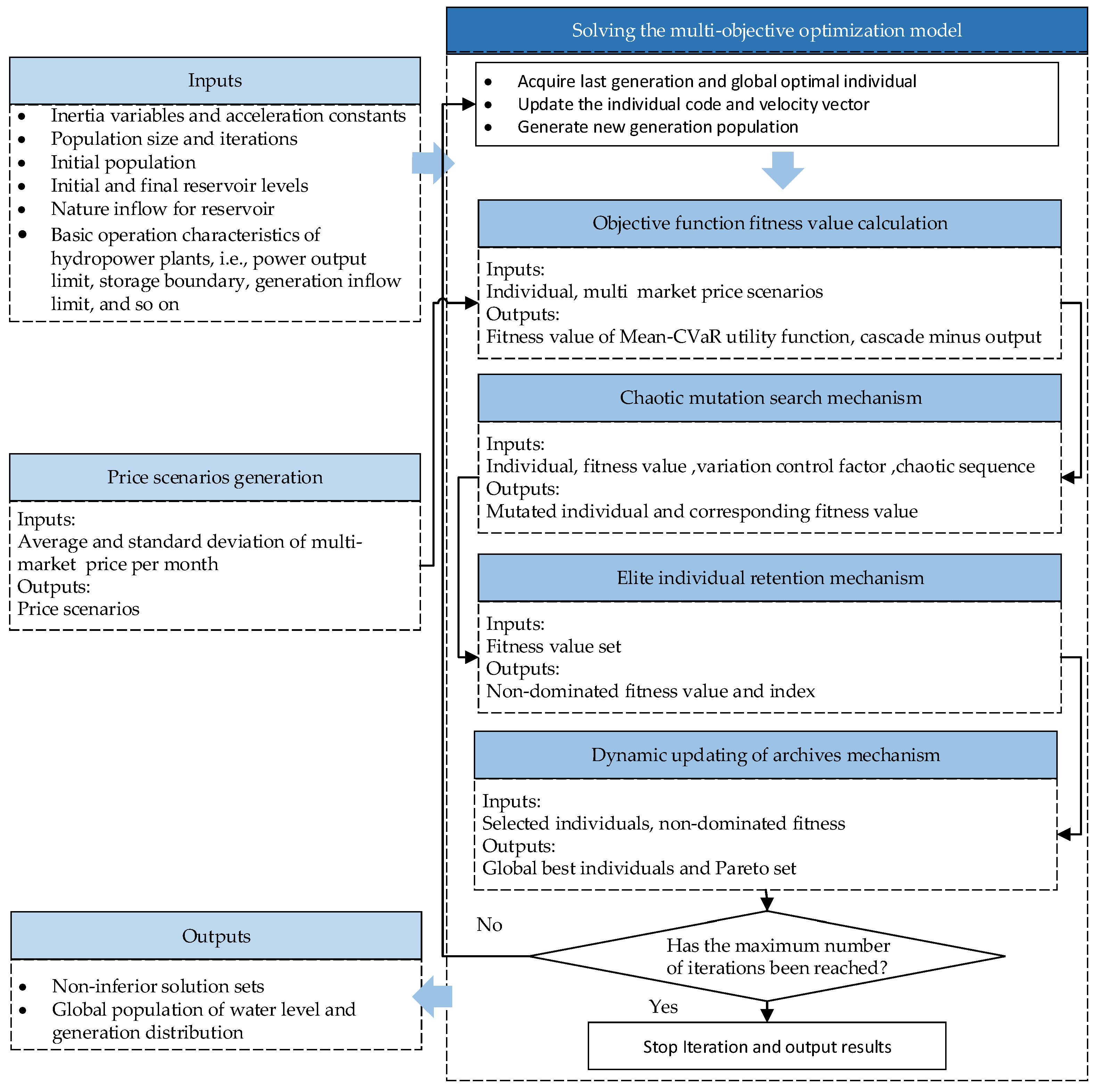
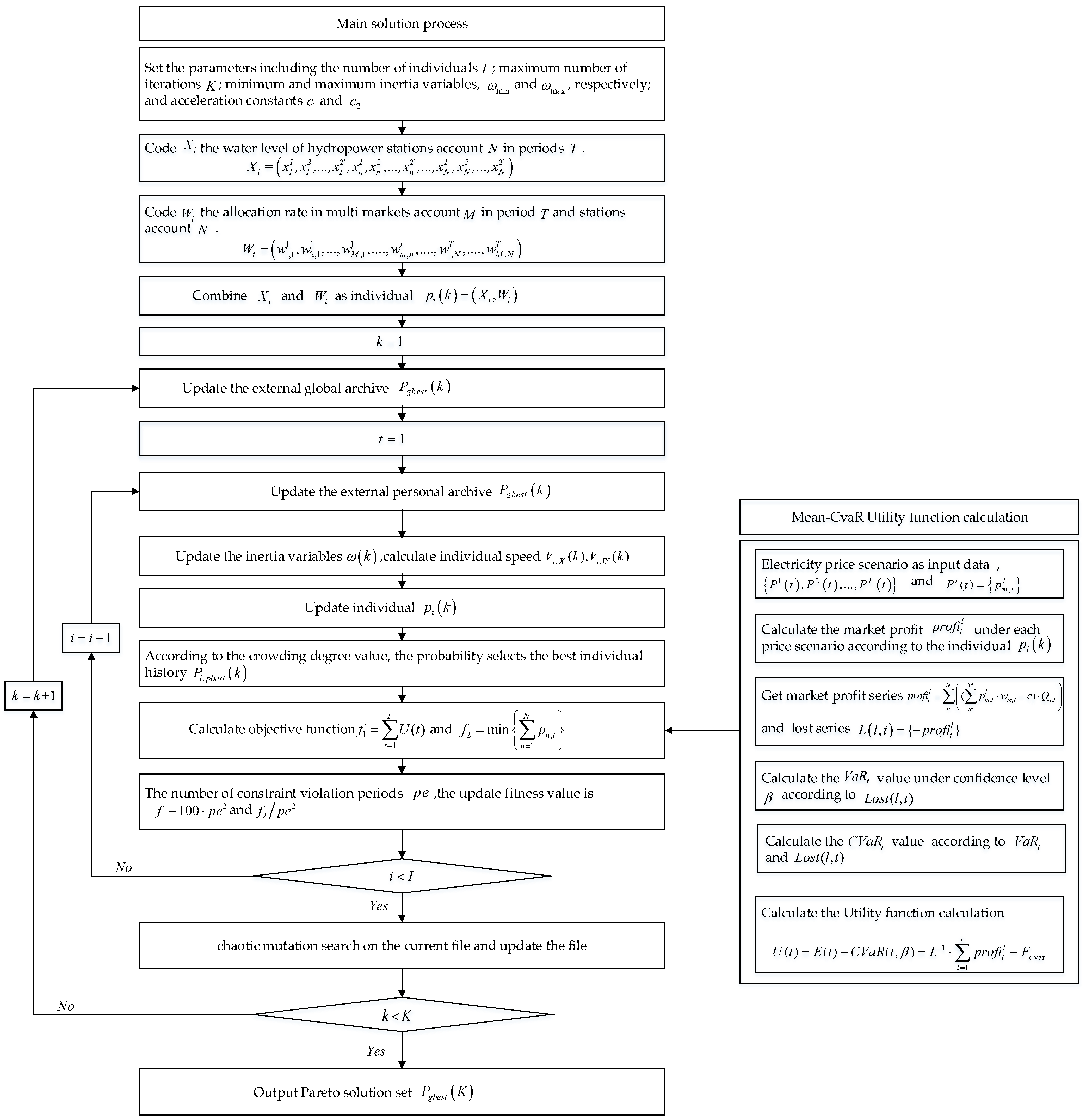

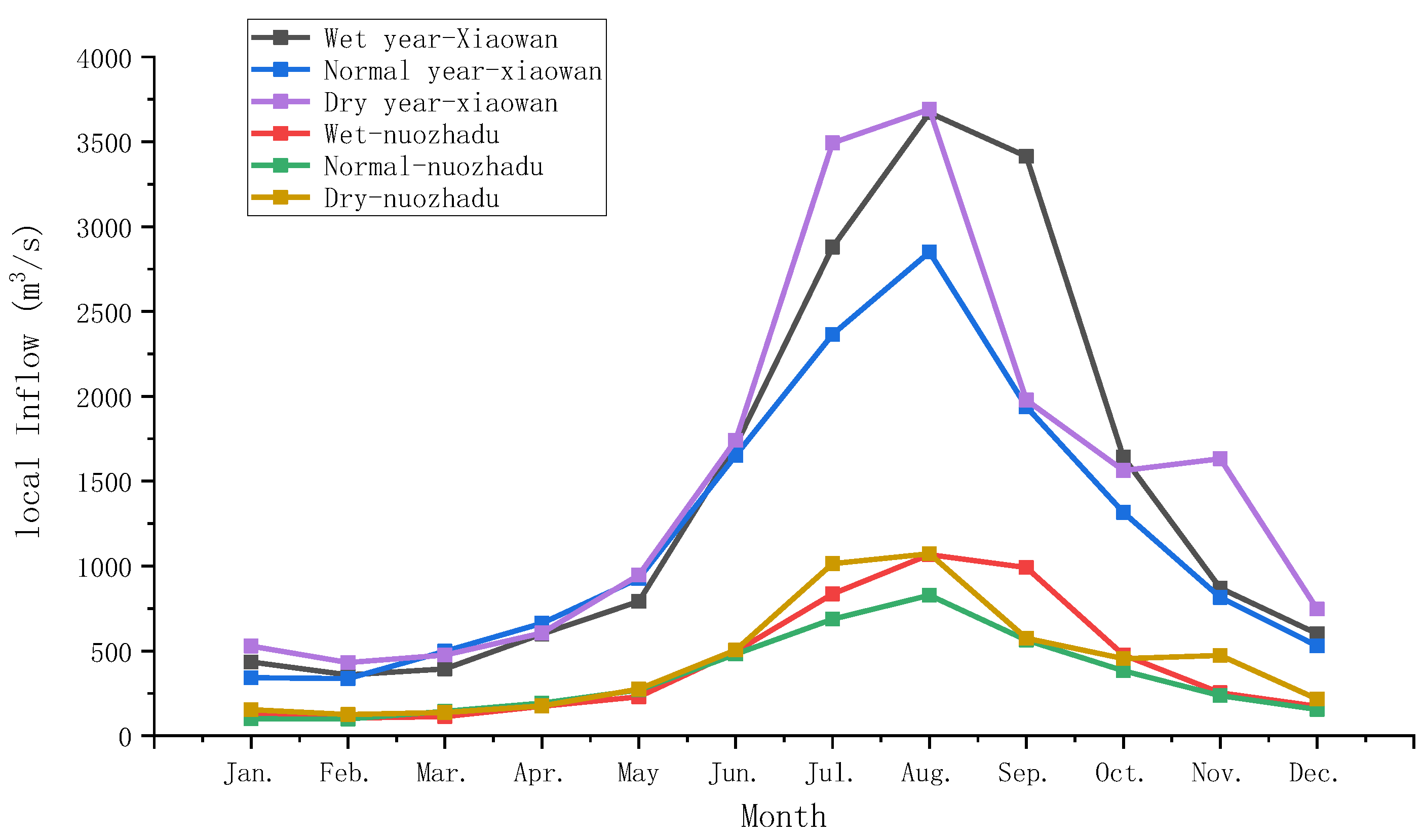
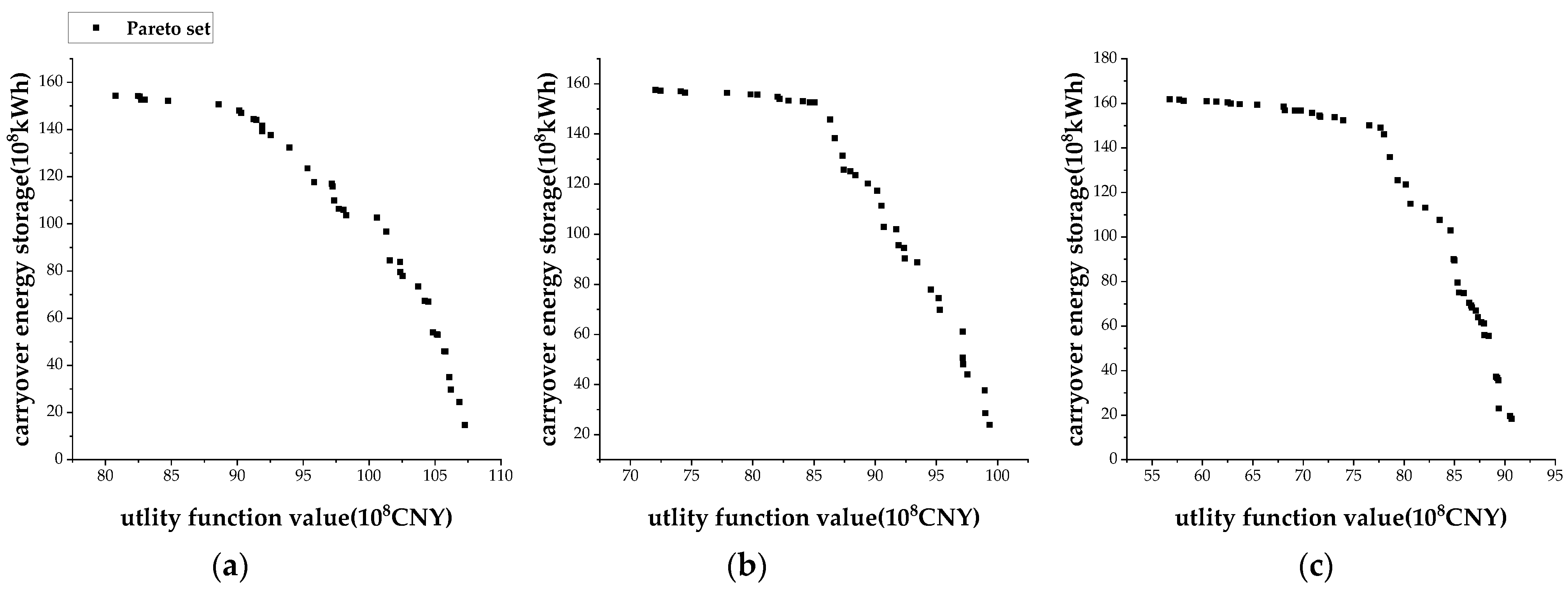
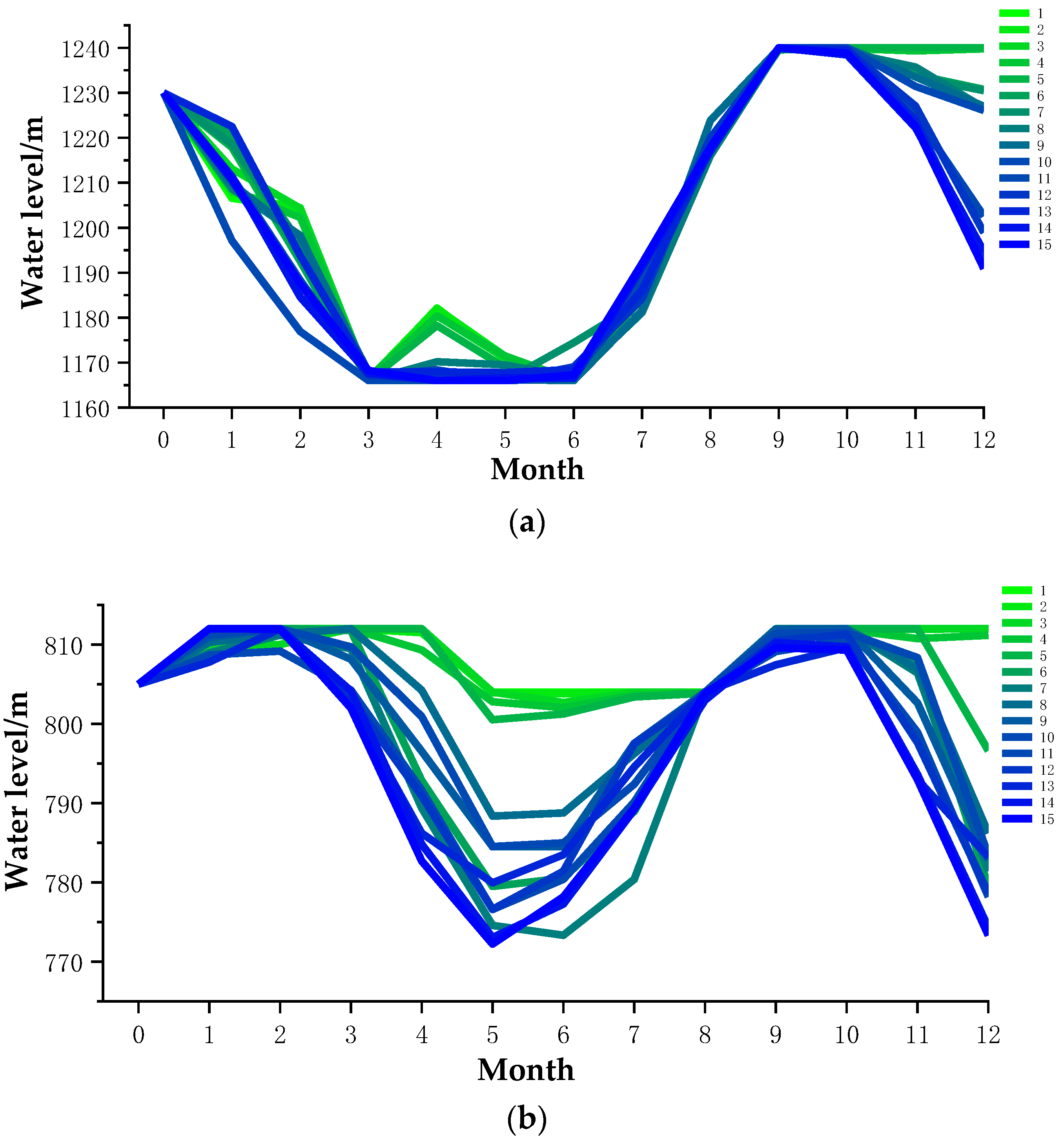
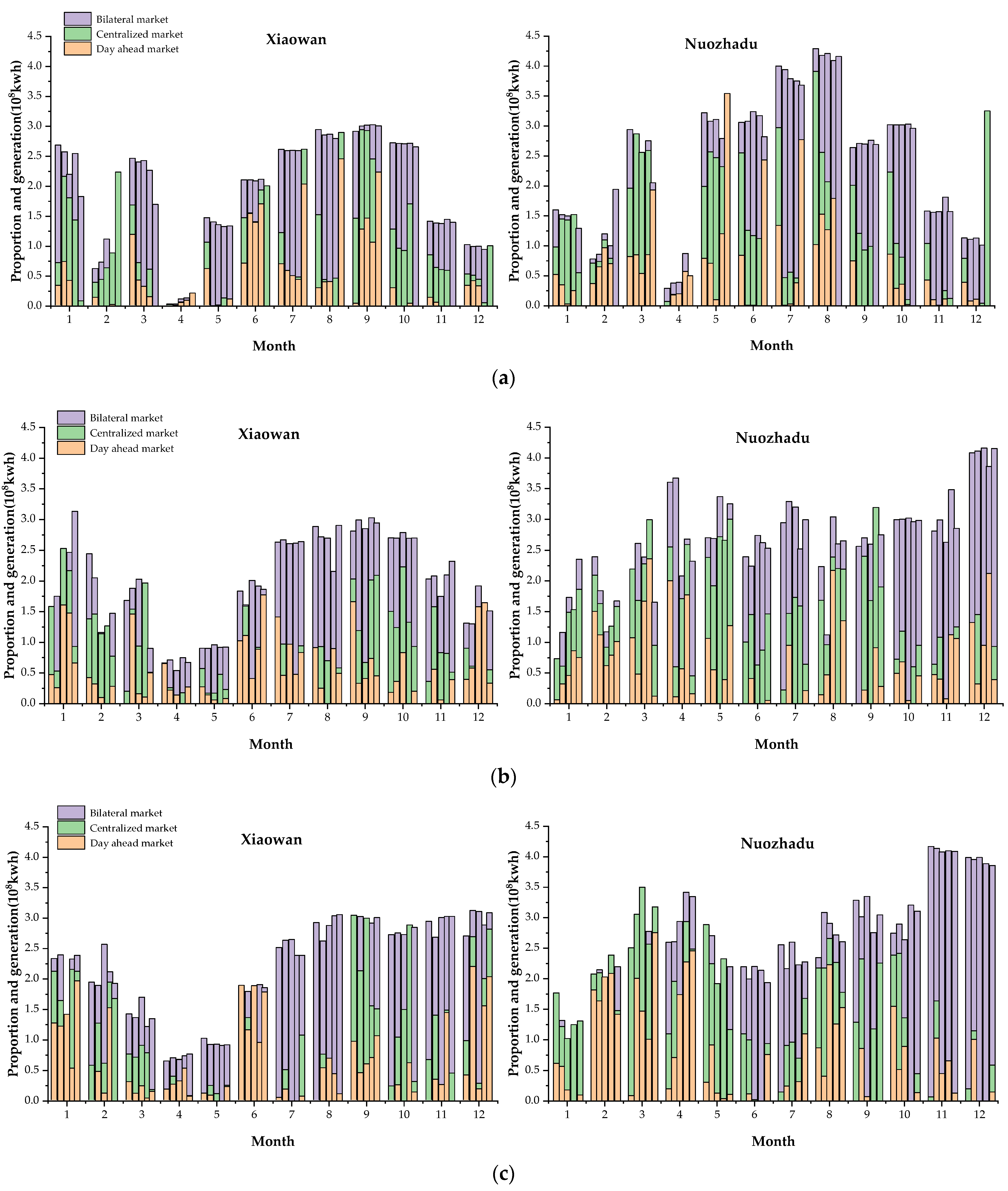

| Plant Name | Installed Capacity (MW) | Normal Level (m) | Flood Control Level (m) | Dead Level (m) | Maximum Discharge (m3/s) | Maximum Generation Flow (m3/s) |
|---|---|---|---|---|---|---|
| Xiaowan | 4200.00 | 1240.00 | 1236.00 | 1166.00 | 20,683.00 | 2202.00 |
| Nuozhadu | 5850.00 | 812.00 | 804.00 | 765.00 | 27,418.00 | 3240.00 |
| Month | Centralized Market | Bilateral Market | Day Ahead Market | |||
|---|---|---|---|---|---|---|
| Avg. | Std. | Avg. | Std. | Avg. | Std. | |
| Jan. | 239.82 | 12.19 | 234.88 | 8.53 | 244.15 | 3.27 |
| Feb. | 242.29 | 14.3 | 233.95 | 2.56 | 246.3 | 5.88 |
| Mar. | 240.11 | 13.02 | 234.85 | 2.46 | 237.77 | 10.25 |
| Apr. | 240.07 | 12.56 | 246.34 | 6.52 | 240.16 | 12.17 |
| May | 236.01 | 13.01 | 231.23 | 2.67 | 238.81 | 9.42 |
| Jun. | 174.58 | 16.79 | 172.04 | 1.83 | 186.58 | 23.12 |
| Jul. | 123.61 | 17.21 | 120.01 | 1.86 | 131.25 | 29.59 |
| Aug. | 114.71 | 18.26 | 112.69 | 1.79 | 123.54 | 34.29 |
| Sep. | 114.66 | 18.8 | 104.57 | 9.97 | 126.4 | 40.79 |
| Oct. | 125.64 | 16.05 | 132.27 | 6.46 | 148.09 | 32.64 |
| Nov | 236.75 | 15.62 | 249.27 | 2.38 | 250.25 | 14.23 |
| Dec. | 244.96 | 19.92 | 275.03 | 15.67 | 270.17 | 18.38 |
| Non-Inferior Set Scheme Number | /Billion CNY | /Billion kWh |
|---|---|---|
| 1 | 8.08 | 15.43 |
| 2 | 8.25 | 15.42 |
| 3 | 8.26 | 15.41 |
| 4 | 8.27 | 15.27 |
| 5 | 8.30 | 15.27 |
| 6 | 9.72 | 11.71 |
| 7 | 9.72 | 11.58 |
| 8 | 9.73 | 11.00 |
| 9 | 9.77 | 10.64 |
| 10 | 9.80 | 10.6 |
| 11 | 10.58 | 4.59 |
| 12 | 10.61 | 3.50 |
| 13 | 10.62 | 2.98 |
| 14 | 10.68 | 2.45 |
| 15 | 10.73 | 1.47 |
| Non-Inferior Set Number | Evaluation Index | ||
|---|---|---|---|
| Minimum Output /MW | Power Generation /Billion kWh | Spillage Energy /Billion kWh | |
| 1 | 459.29 | 51.26 | 0.00 |
| 2 | 670.15 | 51.31 | 0.00 |
| 3 | 875.40 | 51.29 | 0.00 |
| 4 | 1587.29 | 51.42 | 0.04 |
| 5 | 1259.84 | 53.27 | 0.00 |
| 6 | 5264.10 | 55.34 | 0.62 |
| 7 | 6078.05 | 55.00 | 0.57 |
| 8 | 4386.56 | 55.97 | 0.43 |
| 9 | 5632.49 | 55.92 | 0.77 |
| 10 | 4639.70 | 56.09 | 0.55 |
| 11 | 5369.64 | 58.96 | 1.20 |
| 12 | 5583.61 | 59.12 | 1.60 |
| 13 | 5074.72 | 59.77 | 1.02 |
| 14 | 5520.08 | 59.36 | 1.84 |
| 15 | 5394.72 | 59.56 | 2.15 |
Disclaimer/Publisher’s Note: The statements, opinions and data contained in all publications are solely those of the individual author(s) and contributor(s) and not of MDPI and/or the editor(s). MDPI and/or the editor(s) disclaim responsibility for any injury to people or property resulting from any ideas, methods, instructions or products referred to in the content. |
© 2023 by the authors. Licensee MDPI, Basel, Switzerland. This article is an open access article distributed under the terms and conditions of the Creative Commons Attribution (CC BY) license (https://creativecommons.org/licenses/by/4.0/).
Share and Cite
Yu, H.; Shen, J.; Cheng, C.; Lu, J.; Cai, H. Multi-Objective Optimal Long-Term Operation of Cascade Hydropower for Multi-Market Portfolio and Energy Stored at End of Year. Energies 2023, 16, 604. https://doi.org/10.3390/en16020604
Yu H, Shen J, Cheng C, Lu J, Cai H. Multi-Objective Optimal Long-Term Operation of Cascade Hydropower for Multi-Market Portfolio and Energy Stored at End of Year. Energies. 2023; 16(2):604. https://doi.org/10.3390/en16020604
Chicago/Turabian StyleYu, Haojianxiong, Jianjian Shen, Chuntian Cheng, Jia Lu, and Huaxiang Cai. 2023. "Multi-Objective Optimal Long-Term Operation of Cascade Hydropower for Multi-Market Portfolio and Energy Stored at End of Year" Energies 16, no. 2: 604. https://doi.org/10.3390/en16020604
APA StyleYu, H., Shen, J., Cheng, C., Lu, J., & Cai, H. (2023). Multi-Objective Optimal Long-Term Operation of Cascade Hydropower for Multi-Market Portfolio and Energy Stored at End of Year. Energies, 16(2), 604. https://doi.org/10.3390/en16020604







